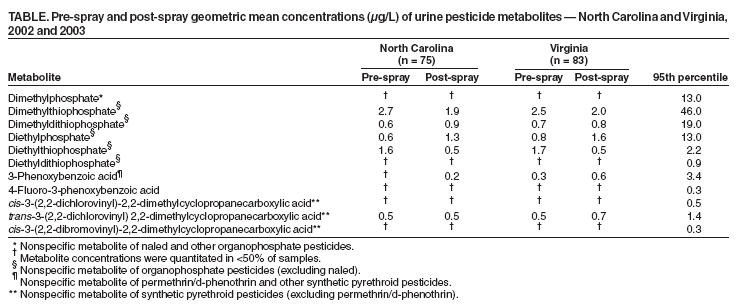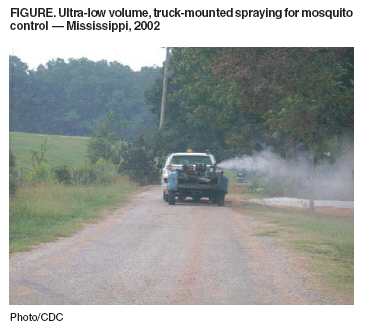 |
|
|
|
|
|
|
|
|
|
|
|
|
|
|
|
|
||||
| ||||||||||
|
|
|
|
Human Exposure to Mosquito-Control Pesticides --- Mississippi, North Carolina, and Virginia, 2002 and 2003Public health officials weigh the risk for mosquito-borne diseases against the risk for human exposure to pesticides sprayed to control mosquitoes (1). Response to outbreaks of mosquito-borne diseases has focused on vector control through habitat reduction and application of pesticides that kill mosquito larvae. However, in certain situations, public health officials control adult mosquito populations by spraying ultra-low volume (ULV) (<3 fluid ounces per acre [oz/acre]) mosquito-control (MC) pesticides, such as naled, permethrin, and d-phenothrin. These ULV applications generate aerosols of fine droplets of pesticides that stay aloft and kill mosquitoes on contact while minimizing the risk for exposure to persons, wildlife, and the environment (2). This report summarizes the results of studies in Mississippi, North Carolina, and Virginia that assessed human exposure to ULV naled, permethrin, and d-phenothrin used in emergency, large-scale MC activities. The findings indicated ULV application in MC activities did not result in substantial pesticide exposure to humans; however, public health interventions should focus on the reduction of home and workplace exposure to pesticides. Mississippi, 2002The 2002 West Nile virus (WNV) epidemic in Mississippi prompted an increase in MC activities, including application of ULV permethrin by truck-mounted foggers (Figure). Because of concerns about potential health effects from pesticides, the Mississippi Department of Health and CDC assessed whether MC activities increased individual urine pesticide metabolite concentrations. During September 8--19, 2002, investigators selected a geographically-random sample of 125 persons by using maps of two regions where public health officials applied MC pesticides and 67 persons from two control regions. Each participant completed a questionnaire describing home and occupational use of pesticides and provided a spot urine sample for analysis of pesticide metabolites 1--4 days after MC (i.e., within 5 half-lives). By using a cross-sectional design, investigators compared urine pesticide metabolite concentrations of exposed and unexposed study participants. Exposure to permethrin was verified by cross-referencing the global positioning systems location of participants with local MC spray routes. Permethrin was applied in MC regions at a concentration of 0.032 oz/acre. Urine samples were analyzed at CDC by using tandem mass spectrometry (3). Urinary metabolite concentrations of 3-phenoxybenzoic acid (3pba), a metabolite of synthetic pyrethroid pesticides such as permethrin, did not differ significantly between MC and non-MC regions (geometric mean [GM] = 1.25 µg/L versus 1.13 µg/L, respectively). Although 3pba concentrations did not differ between participants who used pesticides at home or at work and those who did not, participants who used pesticides on pets (n = 17) had significantly higher (p = 0.02) mean 3pba concentrations than those who did not (n = 174) (4.27 µg/L versus 1.07 µg/L, respectively). These findings indicated that local MC activities did not lead to increased pesticide metabolite concentrations in the urine of participants. North Carolina, 2003Hurricane Isabel made landfall in North Carolina on September 18, 2003. Because of ensuing rains and flooding, mosquito populations were expected to surge. To control mosquitoes and prevent transmission of WNV and other arboviruses, the North Carolina Department of Environmental and Natural Resources (NCDENR) sprayed ULV naled and permethrin. The North Carolina Department of Health and Human Services, NCDENR, and CDC conducted a prospective exposure assessment of ULV spraying of pesticides. Investigators recruited 90 persons from a random sample of census blocks (that accounted for the population density) marked for spraying. Participants then completed a pre-spray questionnaire about household and occupational exposure to pesticides and provided urine samples to quantify concentrations of pesticide metabolites. On September 30, aircraft in North Carolina sprayed ULV naled at 0.7 oz/acre. In addition, trucks sprayed ULV permethrin (Biomist 30+30®) at 0.0014 lbs/acre. Eighteen hours after aerial spraying (approximately one half-life), each participant completed a post-spray questionnaire about household and occupational exposure to pesticides and provided a second urine sample. Urine samples were analyzed at CDC by using tandem mass spectrometry (3). Of the 90 persons recruited to participate in this exposure assessment, 75 (83%) provided pre-spray and post-spray questionnaires and urine samples. The concentrations of all pre- and post-spray pesticide metabolites measured in participant urine samples were low (Table). Dimethylphosphate (DMP), a metabolite of organophosphate pesticides such as naled, was detected in 46% of pre-spray and 49% of post-spray urine samples (limit of detection [LOD] = 0.5 µg/L). The GM 3pba concentration from post-spray urine sampled was 0.2 µg/L. Generalized estimating equations (GEE) indicated no statistically significant differences in the urine concentrations of naled and permethrin metabolites before and after spraying. Participants who ate fresh fruits or vegetables <3 days before completing the pre-spray (n = 58) or post-spray (n = 37) questionnaires had significantly higher urine concentrations of dimethylthiophosphate than participants who did not pre-spray (n = 16) or post-spray (n = 37) (pre-spray: 3.2 µg/L versus 1.4 µg/L; GEE p = 0.02) (post-spray: 3.3 µg/L versus 1.2 µg/L; GEE p = 0.01). Two participants who worked on farms and/or handled pesticides had significantly higher urine concentrations of nonspecific organophosphorus pesticide metabolites (e.g., dimethyldithiophosphate, diethylthiophosphate, and diethylphosphate) than participants who did not work on farms (n = 73) or handle pesticides (n = 72). Virginia, 2003To control mosquitoes and prevent transmission of arboviruses after Hurricane Isabel, the Virginia Department of Health (VDH) decided to spray ULV naled and d-phenothrin. VDH and CDC assessed exposure to ULV spraying of pesticides by randomly selecting 95 residents of high population-density census blocks marked for spraying. Participants then completed pre-spray questionnaires about household and occupational exposure to pesticides and provided urine samples to quantify concentrations of pesticide metabolites. On September 30, aircraft sprayed ULV naled at 0.5 oz/acre while trucks sprayed ULV of d-phenothrin (Anvil 10+10®) at 0.0036 lbs/acre. Eighteen hours after spraying (approximately one half-life), each participant completed a post-spray questionnaire about household and occupational exposure to pesticides and provided a second urine sample. Urine samples were analyzed at CDC by using tandem mass spectrometry (3). Of the 95 persons recruited for the assessment, 83 (87%) provided pre-spray and post-spray exposure questionnaires and urine samples. The concentrations of all pesticide metabolites measured in participants' urine samples were low (Table). DMP was detected in 42% of pre-spray and 48% of post-spray urine samples (LOD = 0.5 µg/L). The geometric mean 3pba concentration from post-spray urine samples was 0.6 µg/L. GEEs indicated no overall difference in the urine concentrations of naled and d-phenothrin metabolites before and after spraying. Reported by: M Currier, MD, Univ of Mississippi Medical Center; M McNeill, MD, Mississippi Dept of Health. D Campbell, MD, North Carolina Dept of Health and Human Svcs; N Newton, PhD, North Carolina Dept of Environment and Natural Resources. JS Marr, MD, E Perry, MD, SW Berg, MD, Virginia Dept of Health. DB Barr, PhD, Div of Laboratory Sciences, GE Luber, PhD, SM Kieszak, MA, HS Rogers, PhD, LC Backer, PhD, MG Belson, MD, C Rubin, DVM, Div of Environmental Hazards and Health Effects, National Center for Environmental Health; E Azziz-Baumgartner, MD, ZH Duprey, DVM, EIS officers, CDC. Editorial Note:Although ULV applications of naled and synthetic pyrethroids have a low toxicity to humans, occupational studies suggest that excessive exposure to these pesticides can cause serious health effects (4). Prolonged exposure to high concentrations of naled and synthetic pyrethroids can cause dermatitis, reactive airway disease, gastrointestinal distress, central nervous system depression, paralysis, and death (5). Exposure often results from use of these pesticides in food production, treatment of wool, wood products, and pest-control efforts; however, few studies have quantitated the level of human exposure to MC pesticides in nonoccupational settings (6). The studies described in this report represent the first efforts to quantitate human exposure to MC pesticides during large-scale MC activities. Two of these studies used a prospective crossover design that compared urine metabolite concentrations after ULV spraying of pesticides with baseline concentrations. Use of sensitive analytic methods in these studies indicated that the urine pesticide metabolite concentrations measured were low (parts per billion). The concentration of urine metabolites in these studies are comparable with those measured in the general population (6,7). In addition, these three studies did not indicate an overall increase of pesticide metabolite concentrations in the urine of participants after spraying during MC activities. The concentrations of naled, permethrin, and d-phenothrin during emergency ULV applications might be too low to cause important human exposure. In certain participants, investigators found an association between home and/or work application of pesticides and pesticide metabolite concentrations. The concentrations in participants who had histories of exposure were within the range of the general U.S. population (8). These findings are consistent with occupational studies in which prolonged exposure to pesticides through several hours of work in plant nurseries and greenhouses was associated with low but measurable concentrations of urine pesticide metabolites (9). These findings also are compatible with a prospective study that quantitated higher 3pba concentrations in the urine of pest-control operators 1 day after spraying pyrethroids (10). The findings in this report are subject to at least three limitations. First, although naled, permethrin, and d-phenothrin remain in the environment for a short period (e.g., naled has a 1-day half-life), CDC did not conduct environmental sampling to confirm the presence of pesticide on the ground after spraying. Second, the study did not quantify the effects of synergists such as piperonyl butoxide in Anvil 10+10®, which help increase the efficacy of synthetic pyrethroids. Finally, the use of self-reported questionnaire data limits the ability to quantify actual home or occupational pesticide exposure. Aerial spraying with ULV naled and truck-mounted spraying with permethrin/d-phenothrin were not associated with an increase in urine pesticide metabolite concentrations among residents of these rural, suburban, and urban communities. These findings suggest that ULV application of naled, permethrin, and d-phenothrin is safe to humans as part of integrated vector control. The findings are noteworthy because ULV applications of pesticides that kill adult mosquitoes are an important tool in the public health response to WNV. Future studies should address the long-term safety of low-concentration exposure to naled and synthetic pyrethroid applications. In addition, public health interventions might be needed to reduce home and workplace exposure to pesticides. References
Acknowledgments The findings in this report are based, in part, on contributions by W Rayburn, Albemarle Regional Health Svcs, Elizabeth City; J Engel, North Carolina Dept of Health and Human Svcs; M Tolliver, North Carolina Dept of Environment and Natural Resources. Z Kazzi, Office of Director, Agency for Toxic Substances and Disease Registry. K Johnson, C Sanchez, A Holmes, R Sabogal, M Patel, A Funk, C Bell, S Young, A Greiling, D Burmeister, Div of Environmental Hazards and Health Effects, C Dodson, Div of Laboratory Sciences, J Mason, E Hansen, J Shughart, Div of Emergency and Environmental Health Svcs, National Center for Environmental Health; A Hedley, Div of Health Examination Statistics, National Center for Health Statistics; G Shaughnessy, G Han, A Terranella, Epidemiology Program Office, CDC. Table  Return to top. Figure  Return to top.
Disclaimer All MMWR HTML versions of articles are electronic conversions from ASCII text into HTML. This conversion may have resulted in character translation or format errors in the HTML version. Users should not rely on this HTML document, but are referred to the electronic PDF version and/or the original MMWR paper copy for the official text, figures, and tables. An original paper copy of this issue can be obtained from the Superintendent of Documents, U.S. Government Printing Office (GPO), Washington, DC 20402-9371; telephone: (202) 512-1800. Contact GPO for current prices. **Questions or messages regarding errors in formatting should be addressed to mmwrq@cdc.gov.Date last reviewed: 6/2/2005 |
|||||||||
|